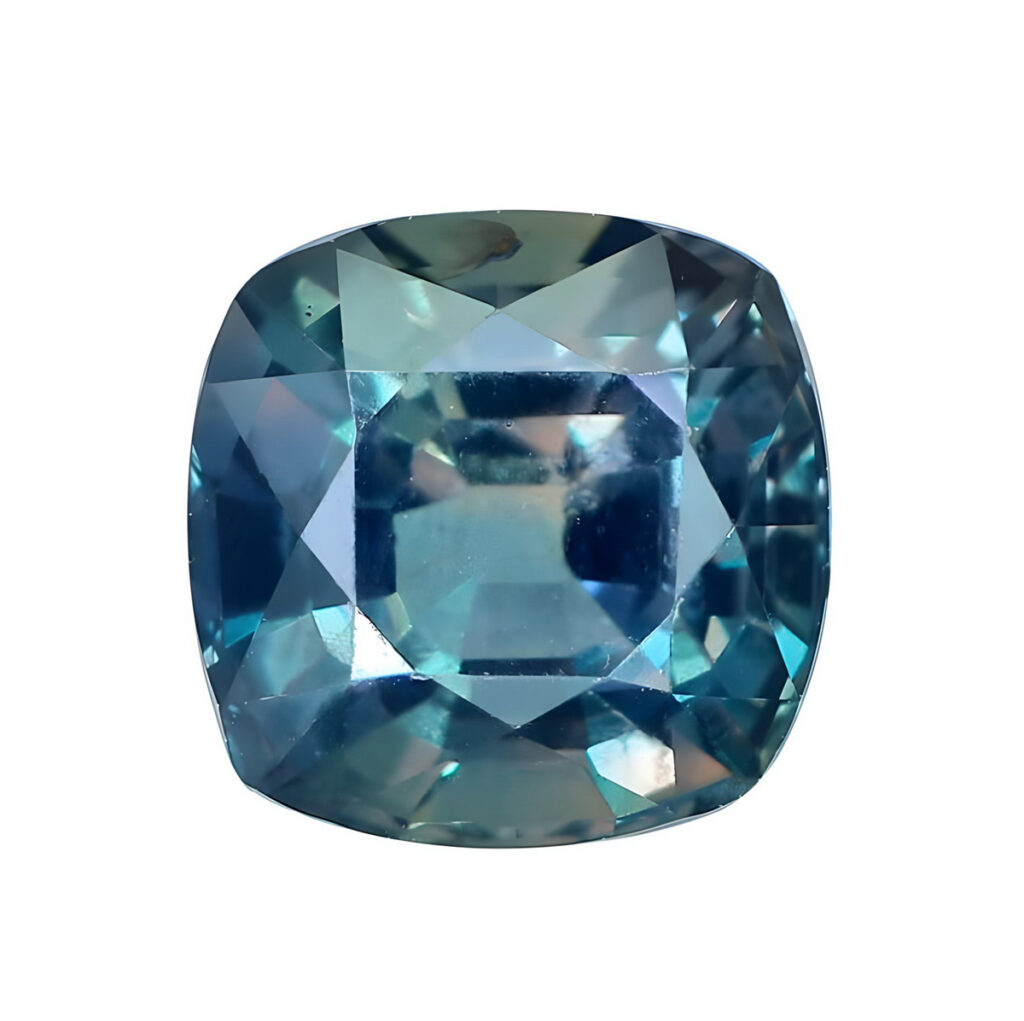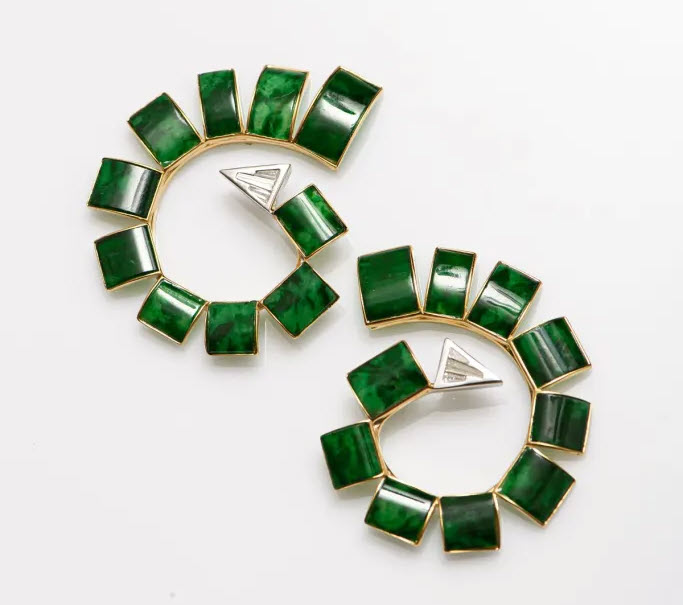Gemstones and art have often been synonymous with wealth and frivolous luxury. I was listening to Field gemologist Vincent Pardieu at the ICA Congress 2019 in Bangkok and was taken aback when ‘resourcefulness’ sprang to mind. We all know up-cycling is good for the environment, but many don’t realise the ways it can positively impact local and developing economies. Since low grade or non gem quality stones make up such a large portion of the overall mining production, local communities such as in Luc Yen, Yen Bai province Vietnam have been utilising gemstone ‘waste’ materials in resourceful ways since the 90’S. They were able to apply creativity and develop sophisticated gem paintings from saving gemstone rejects.

Pardieu identifies that this commercial art industry is adding value to local mining communities, essentially turning worthless material into artistic forms of beauty. “With 5000 dong which is equivalent to less than half a dollar, locals are able to purchase 1kg of rough parcel from miners.” This approach has produced greater economic benefits for the people of Luc Yen. In an elite industry with powerful players and largely established supply chains, here in Luc Yen, the gem’s path from mine to market is reduced to a few kilometers, and profits go directly into the pockets of its local people. Every gemstone type and its location within the Yen Bai province can be traced thus providing a level of transparency. Furthermore, Pardieu expresses that “good quality gemstones are just a byproduct of mining for gemstones paintings. Essentially, if you remove the gem painting industry here in Luc Yen, there will be no more mining” he said.

What are Gem Paintings?
Gem paintings are essentially a handicraft created from natural precious and semi-precious stones. Low grade rough gemstones are sieved, sorted, calibrated, and the vast proportion of low grade gemstones are crushed into colourful powders and used to ‘paint’ the glass or canvas. Afterwards a layer of biodegradable water-based glue is applied onto the surface to fix the stones in place. Popular motifs include historical icons, cascading waterfalls, rice fields to ancient villages and auspicious Feng Shui motifs. You’ll often find these unique paintings hung in local hotels, homes, sold to the tourist market or given as gifts to strengthen business relationships. This artistic tradition began in Jaipur, India, spreading to Thailand and eventually to neighbouring countries including Myanmar and Vietnam. It is said that in the early 90’s, Thai merchants came to Vietnam to purchase tons of kilograms of rubies from the Luc Yen region. Dao Trong Cuong of Than Chau Ngoc Viet Company, a pioneer of this artistic tradition in Vietnam, found it incredibly strange and decided to visit a trade show in Thailand. To his surprise, he found tons of these tiny stones being used to compose glittering paintings. As a miner, he realised the full potential of upcycling local gem materials, Cuong brought this artistic practice back to Vietnam and his paintings grew in popularity.

Andy Warhol Diamond Dust Marilyn Serigraph Sunday B. Morning
For those who’ve encountered a gem painting in person will notice the beautiful interplay of colour and textures that capture the light in a way that brings out their glamorous lustre. The gemstones become the sole pigment and medium itself. When viewed at a distance, the crushed chromatic particles are fused by the eye to form a common solid colour somewhat evocative of Pointillist paintings.
In many ways, this technique of ‘painting with gems’ is also reminiscent of diamond dust paintings produced by the likes of famous artists such as Andy Warhol, who embellished his silkscreens with a sprinkle of diamond dust. Warhol most likely did not consider the act of being resourceful by upcycling boart material! In fact, quite the opposite, since he wanted to showcase the decadence of the vapid social consumerist culture in the West. On the contrary, gem paintings are made by local people from the mines, collecting the “wastes” of opaque gemstone leftovers. Quite the opposite to the shimmering decadence Warhol was trying to achieve.
Gem Paintings in Thailand

The idea of up-cycling low grade rough into gem paintings in South East Asia was originated in Thailand by Mr. W. K. Ho. He was one of the well known gemstone dealers in Thailand from the early 60’s and saw the amazing growth of the gems and jewellery sectors over a period of 40 years. He realized also that Thailand’s economy was agro based with a large majority of the population connected to the planting and tilling of the soil. More importantly, he noticed that the sector was “seasonal” and many farm workers would be idle many months out of the year.
During the idle periods, workers would migrate into the city and look for jobs. The influx of people was often far greater than the number of jobs available. Subsequently many were left jobless or homeless, and people grabbed whatever was offered. In most cases, they ended up in the darker side of society working as bar girls, masseuses or menial jobs as errand boys, drug runners and into crime related activities. Ho also noticed the burgeoning “inequalities” between the “rich” and the “poor” had widened greatly and could see that this dangerous trend would lead to social unrest and an eventual “class” uprising.

Ho traveled frequently and saw that many gem cutting factories, rough gemstone dealers and jewellery manufactures all had disposable “wastes” and “tailings” that nobody wanted. He collected these “wastes” of gemstone chips to be sorted, tumbled (polished) and grouped into different sizes and colours. He then contacted the Universities Art Departments and invited young student artists to create prototypes of products that could be hand crafted into souvenirs and gift products for sale. The aim was to provide jobs for the unemployed, teach them new skills, use gemstone “wastes” and allow them a new source of income so they don’t end up on the wrong side of society. “We had 100 staff and we also adopted villagers and taught them this skillset so farmers can earn extra income when not harvesting rice.” said Kennedy Ho, son of W. K. Ho.
Ho’s initiative sparked off the gemstone pictures, gem critters, gem rocks, gem trees, gemstone lamps and various items that not only was made from natural gemstones but hand crafted by Thais and enabled them to earn extra income. Ho and his wife went to visit local orphanages, the handicapped and to the borders of Maesod, Chiang Mai to the villages to teach these new skills, providing them with the knowledge, training, simple tools and raw materials.

Gem Painting in Africa
At the ICA Congress, Pardieu further urged that gem paintings are a powerful tool to help mining communities, in building lasting, sustainable livelihoods for Africans around their mines. “You simply require one or two persons to provide vocational training, and subsequently they will train others within the mining community,” he said. In Luc Yen, the majority of the gem paintings were created by local Vietnamese women who play a significant part at every step of the gem mining process. Should the same artistic skills be brought over to Africa, this would certainly help place women at the forefront of the gemstone business in countries where the gem trade is traditionally male-dominated. Nonetheless, we are already seeing how this artistic tradition has started to happen in Nairoibi, Kenya. A company called Kariukichao founded by James Kariuki and Evangeline Chao is a gemstone art dealership that combines their love and passion for gemstones and art to create beautiful gem paintings, employing a technique that hasn’t been vastly explored in Africa. For Karuikichao, the art of storytelling is expressed through African imagery and landscapes that are unique to its people and its environment.
Kariukichao’s technique is not entirely the same as those in from South East Asia. They mix the crushed gemstones to bring out various colour shades and no water-based glue is applied on top. Infact, they were not aware of this art form happening in South East Asia: “We initially did not know something similar already existed. Evangeline came up with the idea and we executed it the both us,” said James Kariuki. He expresses “we would love to develop the practice and find different ways to incorporate the gemstones into arts. We would very much love for it to spread to the local people, because we believe it’s a venture that can positively impact the mining sector in Africa.” Both James and Evangeline have every intention to leverage this art form to new heights. Kariukichao recently set up an initiative, GAFA(Gem Arts For Africa), where 10% of revenues from each Gem painting sold is used to help improve the working conditions of artisanal and small-scale miners (ASM) and fund education for kids in the dependent communities. “So far we’ve seen a very positive impact and feedback from the artisanal and small scale miners. The non gem quality material that previously did not have a ready market, now has a market thus has become an added source of income, improving the livelihood of local Africans,” Kariuki said.
Indeed, one of the reasons why gem paintings have flourished more in places like Luc Yen and Mogok (with hundreds of families involved) as opposed to big cities like Bangkok and Nairoibi is because they were introduced very close to the gem producing area where the rough is readily available. Therefore, in order implement this practice effectively in the future, it is important to introduce this at the source & not the capital.
It is fair to say that gem paintings are a testament to the versatility of coloured stones. Even of low grade quality, they can still be used as an expressive medium. Resourcefulness goes hand in hand with creativity when it comes to leveraging waste materials and providing a means for the local community to make a living. From stone paintings, lamps, various trinkets to jewellery design, resourcefulness highlights a necessary undertaking by those involved in this ecosystem. The development of gem paintings certainly has framed new ways of thinking about how communities could benefit from mineral wealth in their countries by upcycling waste materials. The bottom line is that there should be love and appreciation for all materials gifted by Mother Nature. It is through creativity that these gemstones will also shine.
Vincent Pardieu, DANAT.
Special thanks to Vincent Pardieu – Field Gemologist, Henry Ho – Chairman Emeritus of AIGS, Kennedy Ho – Chairman of AIGS Lab & School, Yianni Melas – Gem Explorer, Geir-Atle Gussias – BalderGems & James Kariuki – Kariukichao for their support, personal insights, additional images and information.












